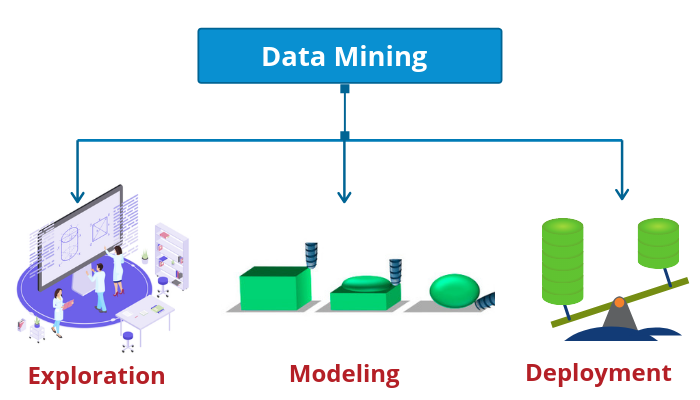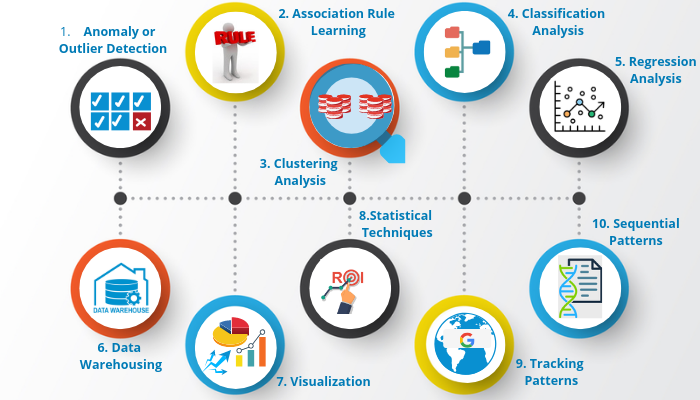The word Data Mining means collecting useful information from the vast quantities of data to make statistically correct decisions and analysis. Data Mining has become one of the most important tools for business success. You need Data Mining, regardless of the type and size of the business you own. For instance, you require data mining to make your growth charts, competitor’s analysis leads generation.
Data Mining is being widely used by businesses across the globe be it B2B or B2C. Data mining techniques are widely deployed these days. More and more companies utilize data mining for all sorts of purposes. Data mining has widespread implications on all kinds of businesses. Data mining is the conjecture of the following steps:
- Exploration: Any data mining technique first begins by gathering relevant information from the vast pool of data. You start by eliminating useless information and duplicate records. Thus, what you are left with is the correct set of relevant data.
- Modeling: Then you start building the prototypes. You set your goals and expectations from the gathered data. You can build multiple models which may or may not lead to the same result. By developing different models, you can determine the most useful one. This can be a laborious task since you are applying different models on the same set of data.
- Deployment: Finally, you test the model and compare it with your old data set. Once thoroughly tested, you can use the new data set in order to draw inferences, identify patterns and make predictions for your business. You can also compare the outcomes of new data against the old data.
Top Data Mining Techniques
Data mining is a highly effective tool and can turn out extremely profitable if used wisely. There are many techniques already thriving in the market. Though no technique can be said as good or bad, it depends on your requirement. Therefore, it is important to choose the right technique to get high-quality results. Therefore, below we mention top 10 data mining techniques for business success.
1. Anomaly or Outlier Detection:
Anomaly or outlier detection refers to pointing out the flaws of the data. The anomaly can be referred to as an erroneous entry that doesn’t match its corresponding values. An object or entry which divulges from the average value of the data set is known as an Outlier. Therefore, detection and removal of Anomaly and Outliers are critical for any business. At BizProspex, we provide a service called Data Verification specifically designed for this purpose.
Data Verification:
At BizProspex, we provide Data Verification services. In this service, we verify the data provided by the business holders. We check for Anomalies and Outliers and replace them with the right set of data. In the end, we furnish ~100% relevant data for any business.
2. Association Rule Learning:
Association Rule Learning is about finding relations or interesting patterns from the large data set. There are times when the databases are so large, they might contain many hidden relations among its variables. However, giving in to their size, it is very difficult to spot those relations. In such cases, businesses might miss out on useful information or opportunities because they failed to identify the hidden relations in their data sets. Thus, association rule learning is the method of identifying hidden relations in the database.
In this method, the occurrences of a particular entry are checked throughout the database. If an entry is repeated many times, then the data researcher tries to spot patterns from the data.
3. Clustering Analysis:
Clustering Analysis is the process of identifying similar data from the large data set and grouping them together. From the business point of view, clustering analysis can help a business understand the similarities and differences of the data. This can help them build Customer Personas, Segmentation of the same kind of leads, etc.
4. Classification Analysis:
Classification analysis is the method of obtaining information about the data. Classification of the data means dividing data in terms of different relevant categories. Thus, classification analysis is complementary to clustering analysis. For example, your email providers classify emails into categories such as inbox, important, spammed, deleted, etc.
5. Regression Analysis:
Regression Analysis lets you study the relationship between the different variables. It analyses the effect of changing the value of one variable on the whole data set. Thus, businesses can benefit a great deal by applying regression analysis as it can help them understand customer relations and calculate customer satisfaction.
6. Data Warehousing:
Data mining is incomplete without data warehousing. Data warehousing is the technique of storing large quantities of structured data securely. Data warehousing is not just limited to storage but is also responsible for the maintenance and security of data. Large-scale business needs Data warehousing to house the data securely.
7. Visualization:
Visualization is the process of tabulating data in the form of graphs, charts and diagrams, and digital images. This helps businesses calculate and draft their growth chart. They can also compare their growths with their competitors and determine their position in the market. Data visualization helps businesses make informed decisions as they have a clear, well-defined picture of data in their minds.
8. Statistical Techniques:
As the name suggests, this technique calculates the mean, mode, and median of the data to predict future patterns. Statistical analysis is very useful for companies as it paves the future path of their business. With the help of statistics, companies can make better decisions, calculate their ROI and devise a marketing strategy keeping in mind the future trends identified with the help of data.
9. Tracking Patterns:
Tracking patterns is the method of identifying patterns from the current database. Tracking patterns comes really handy for businesses as it can help them identify useful patterns out of their data. A classic example can be Google maps, where it predicts the high or low traffic hours on the basis of tracking patterns. Thus, businesses can track patterns to understand the customer’s behavior and use this knowledge to draft a successful marketing campaign.
10. Sequential Patterns:
This is a method of identifying the sequence of the data. Sequential analysis is also very useful for businesses as it can help them track the sales pattern. It can also help companies develop an understanding of the series of events happening in their databases.
Conclusion:
Data Mining has evolved into an excellent tool for all kinds of businesses. BizProspex offers data mining services. We are a young bunch of bustling data enthusiasts. We specialize in everything data. BizProspex has a solution for all your data needs. We offer all the data-mining related services such as data solution, data appending, PEP Lists, Aml sanctions lists, global sanctions database, email appending, data scraping, skip tracing, phone appending, CRM cleaning at a very competitive price. We also offer the first 100 leads for free. In case you don’t like our work, we offer a no-questions-asked 120% money-back guarantee too! Contact us now and let us do the trick for you.


